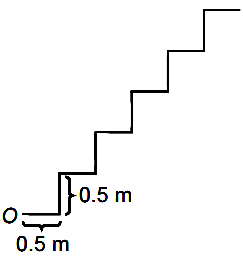Consider a series of steps as shown. A ball is thrown from 0. Find the minimum speed to directly jump to 5th step

Consider a series of steps as shown. A ball is thrown from 0. Find the minimum speed to directly jump to 5th step
- \(5(\sqrt2+1) m/s\)
- \(5(\sqrt2) m/s\)
- \(5(\sqrt{(\sqrt2+1))} m/s\)
- \(6(\sqrt3+1) m/s\)
The Correct Option is C
Solution and Explanation
The Correct option is (C): \(5(\sqrt{(\sqrt2+1))} m/s\)
\(y=x\tan\theta-\frac{gx^2}{2v^2\cos^2\theta}\)
(2.5,2.5) must lie on this
\(⇒1=\tan\theta-\frac{g\times2.5}{2v^2\cos^2\theta}\)
\(⇒ \frac{25}{2v^2\cos^2\theta}=\tan\theta-1\)
\(⇒ v^2=\frac{25}{2}\left\{\frac{1+\tan^2\theta}{\tan\theta-1}\right\}\)
\(⇒ v_{min}=5\sqrt{\sqrt2+1}\)
[ Happens when \(\tan\theta=\sqrt2+1\) ]
Top Questions on Speed and velocity
- Earth has mass 8 times and radius 2 times that of a planet. If the escape velocity from the earth is 11.2 km/s, the escape velocity in km/s from the planet will be:
- JEE Main - 2025
- Physics
- Speed and velocity
- A fluid flows through a pipe with varying cross-section. If the velocity at the narrow section is 3 m/s and the cross-sectional area is half of the wider section, what is the velocity in the wider section?
- BITSAT - 2025
- Physics
- Speed and velocity
A body of mass 1000 kg is moving horizontally with a velocity of 6 m/s. If 200 kg extra mass is added, the final velocity (in m/s) is:
- JEE Main - 2024
- Physics
- Speed and velocity
The velocity (v) - time (t) plot of the motion of a body is shown below :

The acceleration (a) - time(t) graph that best suits this motion is :
- NEET (UG) - 2024
- Physics
- Speed and velocity
A wheel of a bullock cart is rolling on a level road, as shown in the figure below. If its linear speed is v in the direction shown, which one of the following options is correct (P and Q are any highest and lowest points on the wheel, respectively) ?

- NEET (UG) - 2024
- Physics
- Speed and velocity
Questions Asked in JEE Main exam
- Two projectiles are fired with the same initial speed from the same point on the ground at angles of \( (45^\circ - \alpha) \) and \( (45^\circ + \alpha) \), respectively, with the horizontal direction. The ratio of their maximum heights attained is:
- JEE Main - 2025
- Projectile motion
- A rod of linear mass density $ \lambda $ and length $ L $ is bent into the form of a ring of radius $ R $. The moment of inertia of the ring about any of its diameters is:
- JEE Main - 2025
- Moment Of Inertia
- A and B alternately throw a pair of dice. A wins if he throws a sum of 5 before B throws a sum of 8, and B wins if he throws a sum of 8 before A throws a sum of 5. The probability that A wins if A makes the first throw is:
- JEE Main - 2025
- Probability
Let a line passing through the point $ (4,1,0) $ intersect the line $ L_1: \frac{x - 1}{2} = \frac{y - 2}{3} = \frac{z - 3}{4} $ at the point $ A(\alpha, \beta, \gamma) $ and the line $ L_2: x - 6 = y = -z + 4 $ at the point $ B(a, b, c) $. Then $ \begin{vmatrix} 1 & 0 & 1 \\ \alpha & \beta & \gamma \\ a & b & c \end{vmatrix} \text{ is equal to} $
- JEE Main - 2025
- 3D Geometry
- Two projectiles are fired from the ground with the same initial speeds from the same point at angles $ (45^\circ + \alpha) $ and $ (45^\circ - \alpha) $ with the horizontal direction. The ratio of their times of flights is:
- JEE Main - 2025
- Projectile motion
Concepts Used:
Speed and Velocity
The rate at which an object covers a certain distance is commonly known as speed.
The rate at which an object changes position in a certain direction is called velocity.
Difference Between Speed and Velocity:

Read More: Difference Between Speed and Velocity